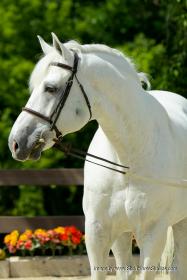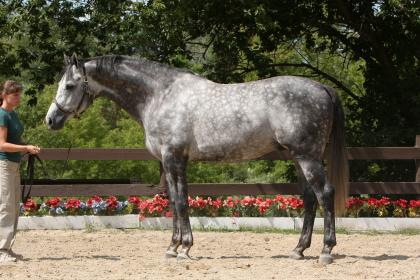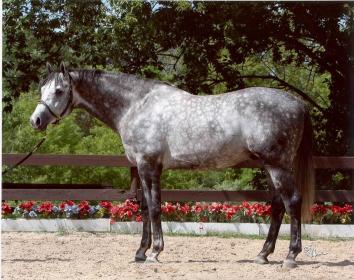I am hauling two of my girls down to our local show barn in hopes of getting some awesome shots of my 16 month old filly and her mother, a 6 yr old oldenburg broodmare. We will have plenty of help, thankfully. I have a Canon t2i with a 55-250 lens and also a wide angle lens if needed. Suggestions welcome!!!
Flat level ground.
Near legs with vertical cannon bones, off legs enough under the horse to clear the near legs from the knee/hock down. He should not be leaning forward over his shoulders. The look should be very upright.
Head/neck straight forward in a relaxed position. At best, the head (but not the neck) can be turned slightly towards you, but that skews the view of the throatlatch a little if you’re going to get picky. It’s not that the pose is bad, as it’s a very, very common one and a pretty one because you get to see more of the horse’s face, but if you are trying to more accurately judge the confo, you need a very straight head/neck.
If you’re going to show a Hunter confo, then encourage a bit of reaching, looking “over/through the bridle” neck. If a Dressage confo, then a more upright neck but still forward. Nothing makes a neck look worse than the horse “holding it in”, if that makes sense. Shortens it, makes it look too thick on the bottom
Photographer should stand right around the barrel of the horse, very perpendicular. Any shot that comes from too far forward, or too far behind, will enlarge the part closest and make the farther end smaller.
If you go to http://www.bloodhorse.com/stallion-register/ you can see very, very good confo shots of TB stallions that show all the above things, such as this one for Unbridle’s Song (rip :()
What those ^ don’t show is the brilliant Hunter or Dressage pose ('cause they are neither lol). This picture of Cunningham isn’t a true confo pose, but the position and overall look of his neck is what I was referring to in looking over/through the bridle
http://www.minglewoodsporthorses.net/SiteImages/cunning2.jpg
This picture of Lord Leatherdale, while not in the “correct” confo pose, shows a typical Jumper/Dressage head/neck position
http://equisonline.nl/dh_kwpn/MULTIMEDIA/0000013229.jpg
The farther away you can stand and zoom in, the better the perspective will be.
Sunlight behind you - nothing makes it harder to take good pictures with the sun overhead or in front of you.
Light shade or a cloudy day is even better 
Watch for background visual noise. Unless you’re a master at Photoshop, you don’t want poles and posts and other things adding a 5th leg or sticking out the horse’s head or back lol
Ears forward! Someone (maybe other than the handler) should stand far enough away so as not to entice the horse to walk or lean forward, and do something that is very, very interesting - not so much the horse sucks back in his pose.
JB gave you some good tips. Make sure both legs are slightly offset so you can see all 4 in the shot. Hard ground is best - soft ground (arena footing) can make foot angles look wonky.
Shoot a bit crouched down - if you are standing too high, you’ll make the legs look short. Do not shoot at the shoulder or forward of it!
With a 55/200 lens, you’ll need a bit of distance between you and horse - so have space. Make sure your background is clean and uncluttered, and if the mare is dark, make sure the background is not dark.
Take a lot of shots - the joy of digital, you can shoot and shoot and shoot, then pick the best. Experiment a bit with where you are in relation to the horse.
I prefer morning sun (behind me), and fairly light as it makes the horse look shinier. If it is a white (gray, pinto w/ a lot of white, etc) horse, a bit of clouds is good - white is hard to balance, it can glare.
All good advice. Check out these photos:http://www.warmblood-sales.com/HorseDetail.asp?HorseID=29847&UserID=543 (sorry, but I can’t post pics)
The first one with the pine tree behind it I consider a good ammie pic of this horse, although her leg placement could be more correct.
And your positioning will depend alot on the horse’s conformation. If they are abit light in the hindquarters, you will want to shoot from (slightly) behind the withers. Getting in front of the withers will almost always make the head look bad…(unless you are doing an actual head shot).
For instance if you go to the site I posted, look at the head shot of this mare, then compare the shot where she has all those ribbons. (To me) the ribbon shot makes her head look big, while the other one is an accurate representation of her actual head.
So, just like with people, the goal is to accurately represent your horse but still make them look their best (like a dating site :D).
And I will give you the MOST important tip of all that has not been mentioned: use the heck out of the “continuous” feature…because horses move all the time (especially those ears). And that means the photographer will also have to be moving. But the continuous feature will really help…You will get your best shots if you take 3-4 at a time…as an example, the woman who took most of these shots (not really a pro, but she’s done it alot) took hundreds and hundreds and hundreds of pics. After she culled the really bad ones I still had over 200 to choose from!!
So make sure you have a HUGE memory card and lots of charged batteries.
Having stood up a bunch of horses for TB sale shots… it takes a LOT of patience from the photographer and handler. A good handler really helps…but the handler cannot exactly see where each leg is in relation to the proper angle, so the photographer must provide good direction (“LF forward an inch…RH back half a footprint,” etc).
A good handler has to get a good length of neck, and yet keep the horse from leaning forward and moving the feet. Pushing back on the horse shortens the neck. Ideally, the horse will stand properly positioned on a loose shank…this may take some work! Practice beforehand if you can. Ask the horse to stand up in very small, deliberate steps (forward and/or backward) and allow the horse to balance itself. Many will set themselves up if you give them a chance.
Find an area with a clean background, level footing, and few distractions. Use lots of fly spray…nothing worse than having all 4 feet perfect, ears up…and a stomp when the shutter snaps, or tail swishing. To get pricked ears, use crinkly peppermint wrappers, or an audio recording of a horse whinny (find a youtube video on your phone, in a pinch!).
Here are 50+ pages of beautiful TB stallion conformation shots. (Note: For the first X number of pages, the link has been removed and the URL has been inserted. This is probably because the online stallion register changes each year, so links for anything but the current year are no longer active. If you start looking at P 11 or so, you will see the blue hyper-links)
http://www.thoroughbredchampions.com/showthread.php/833-New-conformation-pics
Pay special attention to where the camera is aiming. Not at the shoulder but at the ribs. (if the horse keeps moving, follow him so the camera keps facing his ribs. Do not expect the handler to always have him standing at the perfect angle.)
Also notice the height of the camera. The height can vary dpending on how tall they want the horse to look. So, remember that there is not set height for the camera, butit is an issue to be noted for the best result.
While TBs tend to want a higher neck carriage than the hunter breeders do, a common mistake when trying to get a nice smooth topline is to hold a treat out in front of the horse. All well and good BUT, you do not want the horse leaning forward over his front legs. Make sure that the inside front leg is vertical.
Also note the angle that the head is turned. You do not want a full profile. Viewers want to see the facial expression and the look on the horse’s eyes.
And look at the shadow on the ground in back of the horse. Each horse is stood up so as to avoid big shadows on his neck. Take pictures around noon and put the sun over the photographer’s right shoulder.
As some have said, crouch down and shoot up at the horse, watch the backround, watch the shadows. Here are some taken by Short Horse Studios.
Nancy




Great advice JB and others! Crouching down slightly, as MysticOakRanch suggested, is a very good idea. Be careful that you are not too close and standing up too tall. Standing perpendicular with the barrel, as JB said, and crouching down until your camera is at the level of the horse, will give you a good conformation shot without the short legs that so many people accidentally get.
